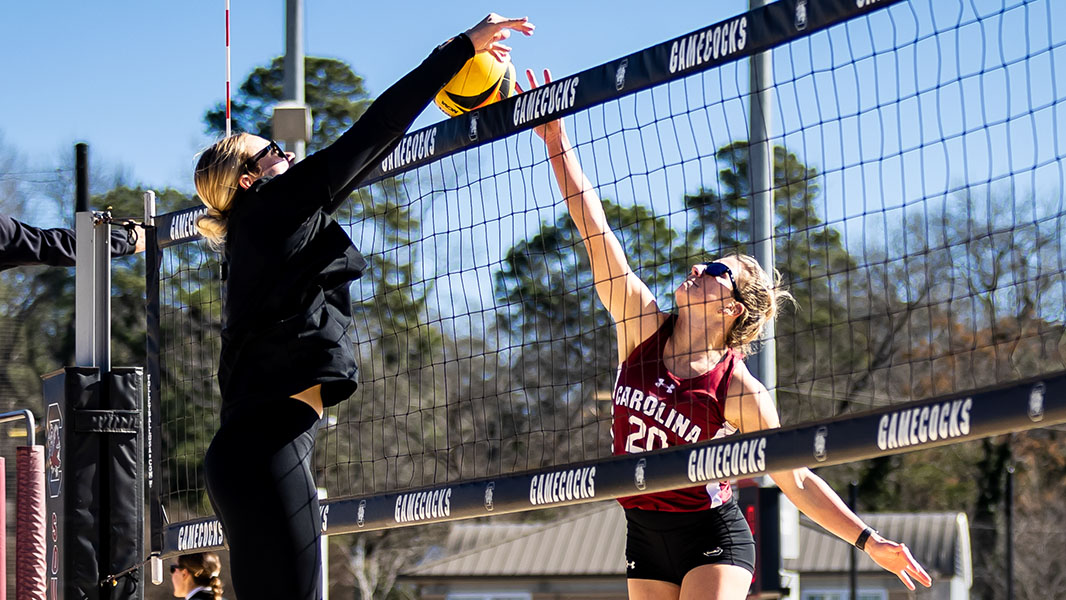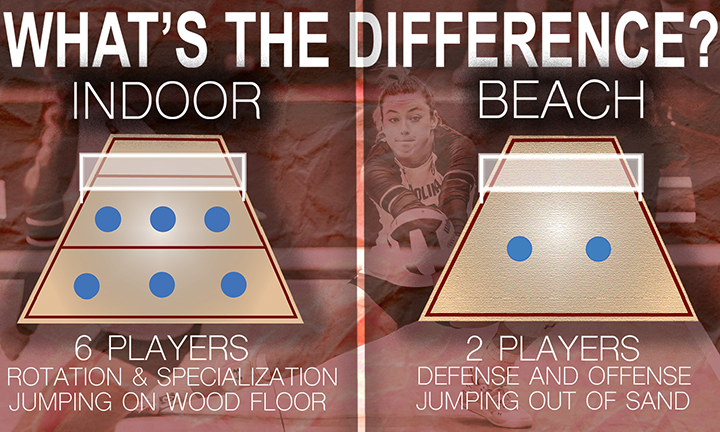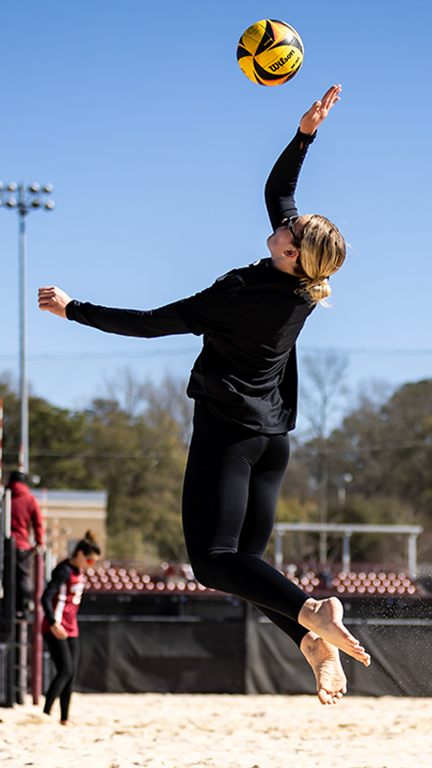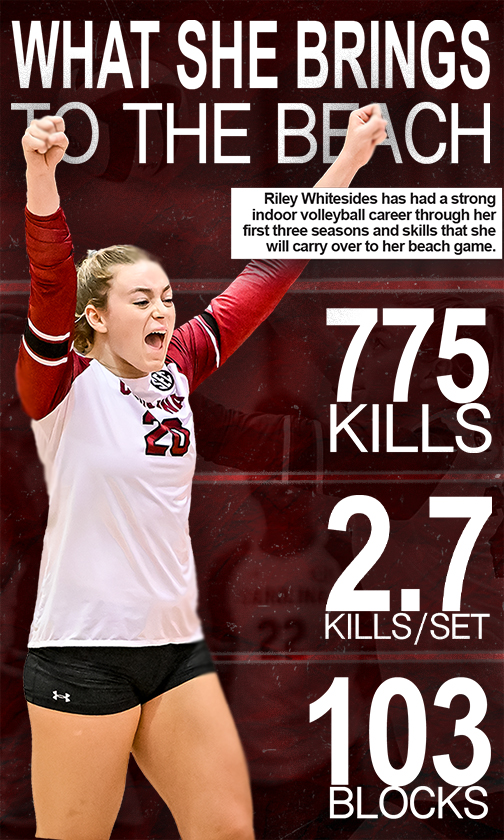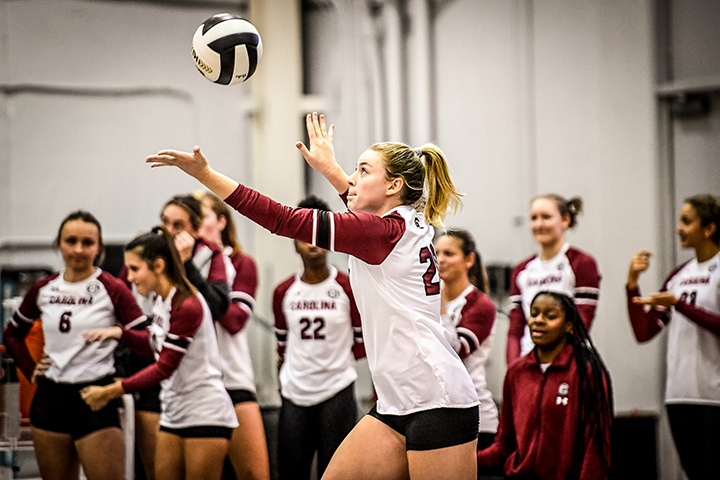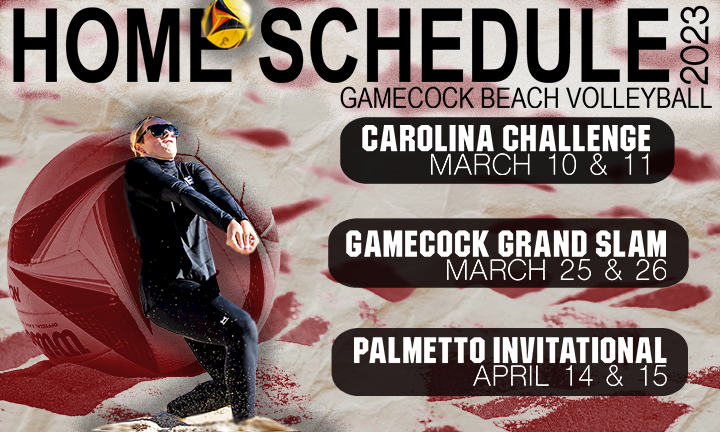Riley Whitesides (left) brings a broad skillset to the beach, including hitting and blocking prowess from playing the indoor game. (Photos and graphics by Caroline Barry)
Many would assume that making the transition from playing indoor volleyball to beach volleyball is a simple one. But, in reality, the two sports are very different, each requiring a unique skill set.
Beach, or sand volleyball, is a newer addition to Division I NCAA sports. Instead of six players on a court in rotation, two players on each side battle for every point in the sand.
University of South Carolina Indoor Coach Tom Mendoza and Beach Coach Moritz Moritz agree it takes a truly special kind of player to do both. They also agree outside hitter Riley Whitesides fits that mold.
“(Riley is) just a really, really quality person, very driven as an athlete,” Mendoza said. “She understands how to be successful herself while still being a great teammate. And I think that’s what makes her special.”
Whitesides is not the first crossover athlete. She follows in the footsteps of other players such as Jess Vastine and Courtney Weber, who each competed in both sports. Indoor players bring their floor skills to the beach game and grow their indoor game simultaneously.
Why beach volleyball?
Why might a player decide to become a crossover athlete?
Every player who does this has a different response. For Whitesides, it was always something she wanted to do.
“I’ve always thought that it would just be so rewarding and relaxing and fun for me,” she said. “And my freshman year was during COVID, so we played indoor the whole year. And then sophomore year, I just never really had the guts to … make the switch.”
This year, her junior year, she finally felt ready to give it a shot.
Beach volleyball has given Whitesides the opportunity to be outdoors, interacting with a new team and a new group of athletes.
“I get to compete all year round, which I love,” she said.
What Whitesides brings to the beach
Playing all six rotations in the indoor game, Whitesides is rarely on the bench. She has the ability to bring top-tier blocking, attacking and defensive skills to the beach.
Beach volleyball requires an athlete to do everything, as there are only two players on the court versus the six-player rotation in indoor. The main difference between beach and indoor is there is no rotation that allows you to specialize in defense or offense. The athlete has to do everything on almost every play.
Whitesides, according to both coaches, is well-suited for the challenge.
“Since we only have two players, obviously we have to be skilled in everything,” Moritz said. “Passing, setting, attacking, blocking – all of those things where you can be on the indoor side – you can be a lot more specialized. Making the transition to beach is usually smoother because you’re looking at an outside hitter when you’re talking about Riley.”
Mendoza echoed this sentiment.
“Riley’s a very big competitor, so if you offer her the opportunity to be in season and get to compete during the spring, I think she feels like that’s a pretty good experience for her,” he said.
The crossover athlete also served as captain for the indoor team. It was a unique experience for the junior to be a leader for her teammates.
Whitesides’s innate competitiveness paired with her experience as a six-rotation, outside hitter set her up for success in the sport.
How will the beach help her indoor game?
Playing beach volleyball also allows Whitesides to make strides in her indoor game.
One of the main benefits of the experience is Whitesides’ improved overall fitness. This comes largely from getting her “sand legs,” or the ability to elevate out of the sand to hit or block.
Getting “sand legs” improves a player’s vertical jump, something Whitesides and Mendoza both hope will carry over to the fall indoor season.
“Jumping out of the sand is very difficult,” Mendoza said. “And so, hopefully, when she comes back to indoor, she’s even added a few more inches to her vertical, which is something we’ve seen players do.”
Whitesides said beach volleyball is increasing her endurance and strength to return to the indoor game in the fall.
“Jumping in the sand is really hard, and so when I go back onto the hardwood floor in a regular gym, I’m going to feel like I’m jumping higher, which I probably will,” she said.
“In beach, you’re always going to be involved,” Whitesides said. “… There’s nowhere to hide on the beach court which will help my confidence for sure, because I’m going to be used to getting a lot of balls and getting a lot of swings and touches.”
Sports and studies: in harmony
One of the hardest parts of being a Division I athlete is finding the balance between school, sport and the athlete’s social life.
Adding another sport into the mix is certainly a challenge. But it is a challenge Whitesides relishes.
Not only is Whitesides a two-sport athlete now, but she is also a psychology major. Learning about psychology has helped her understand herself as an athlete and work through challenges, she said.
“I honestly love psychology because I get to learn about myself a lot,” she said. “It helps me discover things about myself, even the people around me.”
Whitesides acknowledges that being a one-sport athlete at the Division I level is hard enough, but adding a second sport is even harder.
She is able to relate her studies to her lived experience as a new two-sport athlete, which helps her to work through any bumps along the way.
The relationship between beach and indoor volleyball is sure to be symbiotic for Whitesides. She’ll find out when she makes her home debut on the beach March 10.
Beach volleyball became a sport at the university in 2014, and is continuing to grow at the Division I level nationally.
Riley Whitesides, who is a 5-foot-11-inch outside hitter also brings some additional height to South Carolina’s beach volleyball team.
Whitesides has consistently been among the statistical leaders for kills on the indoor team through her first three seasons.
Whitesides plays all six rotations in indoor volleyball, meaning she hits, passes, blocks and serves. (Photo courtesy of University of South Carolina Athletics)

